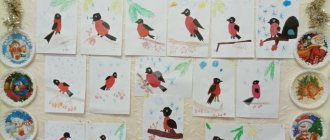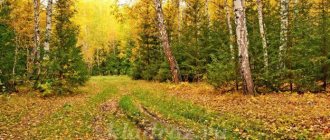Project “My Favorite City” (preparatory group)
Goal: - encourage children to speak out; — test children’s knowledge of city
, your home address.
2. Cognitive - research. Drawing up a map of the street where our kindergarten is located.
2) Independent activity of children. Looking at a map - city
(check the boxes for the most interesting places
in the city
, places where the children have already been).
3) GCD. Design “The area in which our kindergarten is located”
.
Goals: - expand and clarify children’s ideas about the area in which their kindergarten is located; – learn to work collectively, discuss details of work; - develop imagination.
Afternoon.
1) Role-playing game “Streets of my hometown ”
.
Goal: - to help children divide the group
into supposed streets with different play centers organized on them
(hospital, store, pharmacy, police, post office, kindergarten)
;
- develop free communication with adults and children during the game
2) D/i “Lay down a monument”
.
The first half of the day
1) Group/subgroup activities
:
1. Children’s story about interesting places in the city
, where they have already visited.
2. CHHL. Reading poems about your hometown
.
2) Independent activity of children. Looking at books and photographs.
3) GCD. Cognition: “The history of the emergence of our native city ”
.
Goals: - consolidate children’s knowledge about their hometown
;
— introduce the history of the city and its founder
; - cultivate interest in the history of their native land.
Afternoon.
1) Educational - research “Compilation of the Red Data Book of the native land”
.
Purpose: - storytelling, showing illustrations of animals living in our area.
2) Conversation: “What interesting things did you see and remember when visiting the museum?”
3) Drawing on the theme “Animals of our native land”
.
4) Work with parents: offer to find information about the number of streets in the city
and whose names the streets are named after.
Day 5
The first half of the day
1) Group/subgroup activities
:
Compiling and guessing riddles on the topic “My favorite places in my city ”
.
2) Independent activity of children.
Cognitive - research. Looking at illustrations of industrial facilities in our city
.
Afternoon.
1) Educational fairy tale. Goal: - listening to fairy tales and memorizing small genres of oral - folk art from the collection “In a Certain Kingdom”
.
2) Productive. Making the album “My City ”
.
3) D/i “Guess where I am”
.
Project result
:
Knowledge gained during the project
, helped to increase the importance of patriotic education of children and the formation of patriotic feelings among preschoolers.
Parents and educators were convinced of how relevant the topic of studying one’s hometown is
.
The project
interested children and adults, united parents and children in raising future citizens of their
city and country
.
Summary of an educational lesson in a preparatory group on the topic: “My hometown”
Summary of educational lesson
in the preparatory group on the topic: “My native city”
Target:
Expand and generalize children’s knowledge and ideas about their city, its historical past, memorable and remarkable places in their city, people who glorified their city - artists, poets, athletes, etc. Activate children's cognitive interest, attention and memory, develop logical thinking and imagination; enrich vocabulary, develop children’s coherent speech; to cultivate a caring attitude towards the history of one’s native city, to cultivate a sense of respect for those who glorified their city; encourage you to strive to study in such a way as to glorify your city in the future.
Vocabulary:
townspeople, symbols, coat of arms, fortress, monument, guide, landmark, problem, architect, famous, famous, talented, architectural, memorable, glorify, strive, cherish, appreciate.
Materials and equipment for the lesson:
cards with words according to the number of children, a map, coats of arms and symbols of your city and other cities, slides with the sights of the city, memorable places, photographs of these places, photographs of famous and famous people of the city, sheets of paper, brushes, paints, pencils for drawing.
Preliminary work:
- Project activity “Native and beloved land” (acquaintance with the history of the native land)
- Excursion to the memorable places of your city; to the city's local history museum
- Conversation with children about the city and the people who glorified it
- Drawing “My Street”, application “My City” (collective)
- Reading poems about your hometown, works of local poets and prose writers.
Working with parents:
- Folder – movement “Our fellow countrymen”
- Consultation “How to introduce children to their native land”
Progress of the lesson:
IN:
Guys, how old are you? How old are your mothers? Dads? Grandmothers? Grandfathers? All people are of different ages. Do you think cities have an age or are they all the same age? How old is our city? (children's answers)
IN:
Guys, are all cities the same or are they different from each other? How to distinguish one city from another? (children's answers).
IN:
By what signs would you recognize your hometown? (children's answers)
IN:
Show it on the map (children show it). What are the people of our city called? (children's answers)
IN:
If you now arrange the word cards in order, you will find out what the word city means:
IN:
How could cities be protected in ancient times? (children's answers). Was our city fenced with a fortress? Why? (children's answers).
IN:
It seems to me that you know a lot about your city. In this case, I want to invite you to the curious club for the game “What? Where? When?" Do you agree? (Yes). Then divide into 2 teams of experts. Captains, take your seats. Now we find out whose team knows more about their city. I will ask you questions. Whose team is faster and, most importantly, answers the question correctly will receive a point, which will be awarded by the jury. At the end of the game, our jury will count the points of each team and name the winner of today's game. Please come up with names for your teams.
IN:
The first task for the teams: tell us what was remarkable about our city in the past, what the people who lived in it did (children’s stories, the jury awards points to the teams).
IN:
The second task for the teams: What will replace what our city is currently known for? (children's stories).
IN:
You know that each city has its own coat of arms, its own symbols. Our city has all this.
D/i “Find and name” (coat of arms, symbols of our city among others). Children explain their meaning. The jury awards points to the teams.
IN:
And now I invite you on a tour of my hometown. We will get acquainted with architectural monuments and visit cultural recreation areas of the townspeople. You will be the only guide. But first you need to check whether you know these memorable places in your city well in order to be a tour guide. I will show you slides with famous places of our city, and you watch and remember. The team that remembers and names them the most will win and earn an extra point (d/i “Remember and name”). They will be the first to conduct the tour.
IN:
Now look at the photographs and choose a place in our city that you will tell us about. (Children choose a photo and talk about the sights of the city, the jury evaluates the children's stories).
IN:
Well, our tour of the memorable places of our city has ended. We "drove" along different streets. Do you remember their names? Let's play the game "Who can name the most streets of their city." The team that remembers the most names is awarded a point.
IN:
Now think about what is good for our streets and what is bad. (D/and “Good - bad” TRIZ).
IN:
Many famous and famous people lived and live in our city. Choose a photo of a person you know and tell us what he became famous for and what he did for our city. (children's stories, the jury awards points to teams).
IN:
Do you think our city has any problems? How can they be solved? (children's answers).
IN:
And now a competition of poems about our city is being announced. (children's answers).
IN:
Well, guys, how much, it turns out, you know about your hometown, how much you love it. Let's think, dream, how will you be useful to your city when you grow up? (children's stories).
IN:
Now let's listen to our jury, who will sum up the results and name the team that will win today's game.
The jury announces the winners and awards prizes. The teacher invites the children to draw their favorite city for the exhibition of children's drawings “My Native City”.



